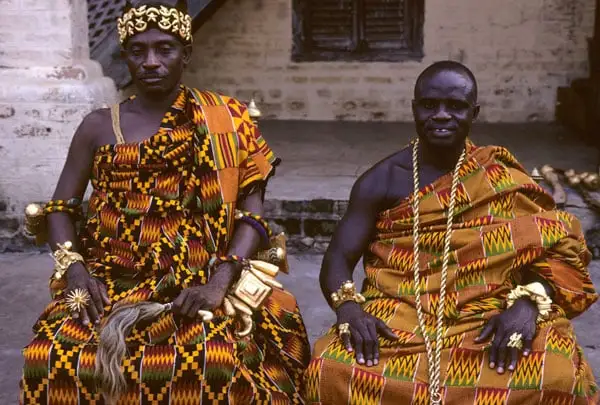History of kente cloth: Where, when, who and how it started
When you think of Ghana, what’s the first thing that pops into your mind? For many, it’s the vibrant, intricately woven fabric known as Kente.
This isn’t just any cloth; it’s a symbol of pride, history, and cultural identity for Ghanaians. But have you ever wondered how this iconic fabric came to be?
Let’s unravel the rich history behind Kente and why it’s not just fabric but a narrative woven through time.
How it started
Kente, deriving from the Akan word ‘kenten’ meaning basket, is a testament to Ghanaian ingenuity and cultural richness, deeply rooted in the traditions of the Ashanti and Ewe peoples.
The legend of its origin is as captivating as the fabric itself, dating back over 400 years to two Ashanti hunters, Opoku Kwaku and Kwakye Ameyaw. Their encounter with a spider at Ayowakese, near Bonwire, spinning an expansive web inspired them to weave something equally mesmerizing.
Yet, with no threads or cloth in hand, they turned to the raffia plant, ingeniously using their own toes and waist as a loom in the weaving process.
Initially named ‘ayaase ntoma’, or ‘waistcloth’, because of the method of wrapping it around the waist, the fabric’s evolution continued as the weavers sought to create larger pieces.
They began using wood and nails to construct a rudimentary loom, leading to the name ‘Asaase ntoma’, or ‘earth cloth’, reflecting its creation on the ground. This period of innovation was marked by a reliance on raffia until the dawn of European trade introduced new materials.
With the arrival of European traders, the locals saw an opportunity in the scarves worn by women. By unravelling these scarves, they obtained thread, which then became a replacement for the raffia plant.
This marked a significant turning point in Kente weaving, enhancing its texture and variety of designs. Initially exclusive to Asante royalty and significant ceremonies, Kente’s prestige and importance have remained intact through the centuries.
The Kente loom was developed 20 years later and its evolution from ‘ayaase ntoma’ to the revered status it holds today is a reflection of the adaptability and creativity of the Ghanaian people.
As Kente continues to be a symbol of identity, heritage, and pride, its story is not just about the fabric but about the community and history it represents.
From its humble beginnings inspired by nature to its status as a global icon of African culture, Kente embodies the spirit of innovation and the enduring legacy of the Ashanti and Ewe people.
It stands as a vibrant reminder of Ghana’s rich cultural tapestry, woven into the very fabric of its history.
Kente today
From its royal roots in the Ashanti Kingdom, Kente has journeyed onto the global stage, becoming a symbol of African heritage and pride worldwide.
It’s not just worn; it’s celebrated in various forms, from clothing to accessories, and even in the design elements of significant African-American events and celebrations, like Juneteenth and Black History Month.
Kente’s journey from a local fabric to an international symbol of identity showcases its timeless appeal and the shared history it represents.
So, the next time you see a piece of Kente, remember, you’re looking at centuries of history, art, and culture, all woven into one.
When you think of Ghana, what’s the first thing that pops into your mind? For many, it’s the vibrant, intricately woven fabric known as Kente.



